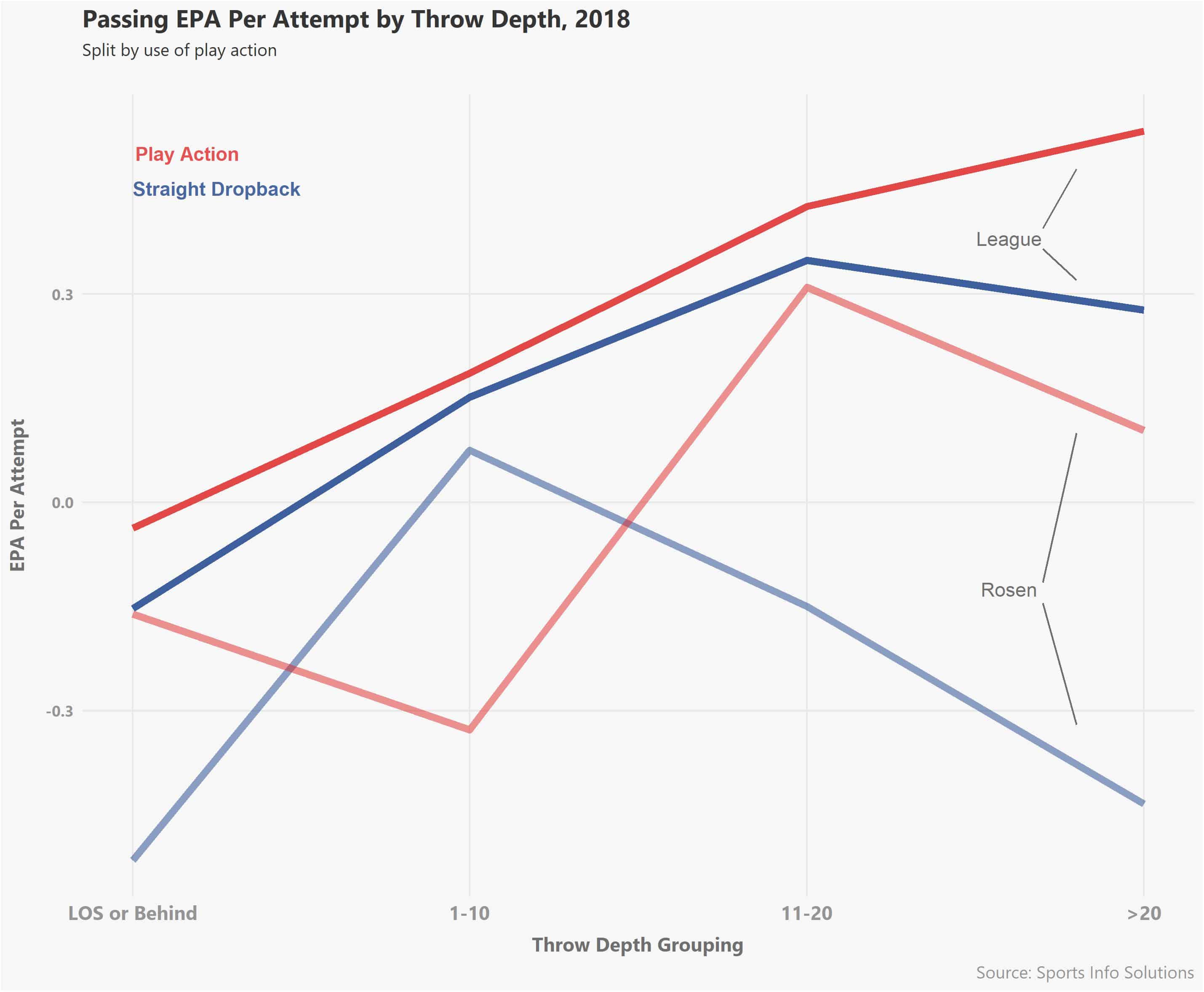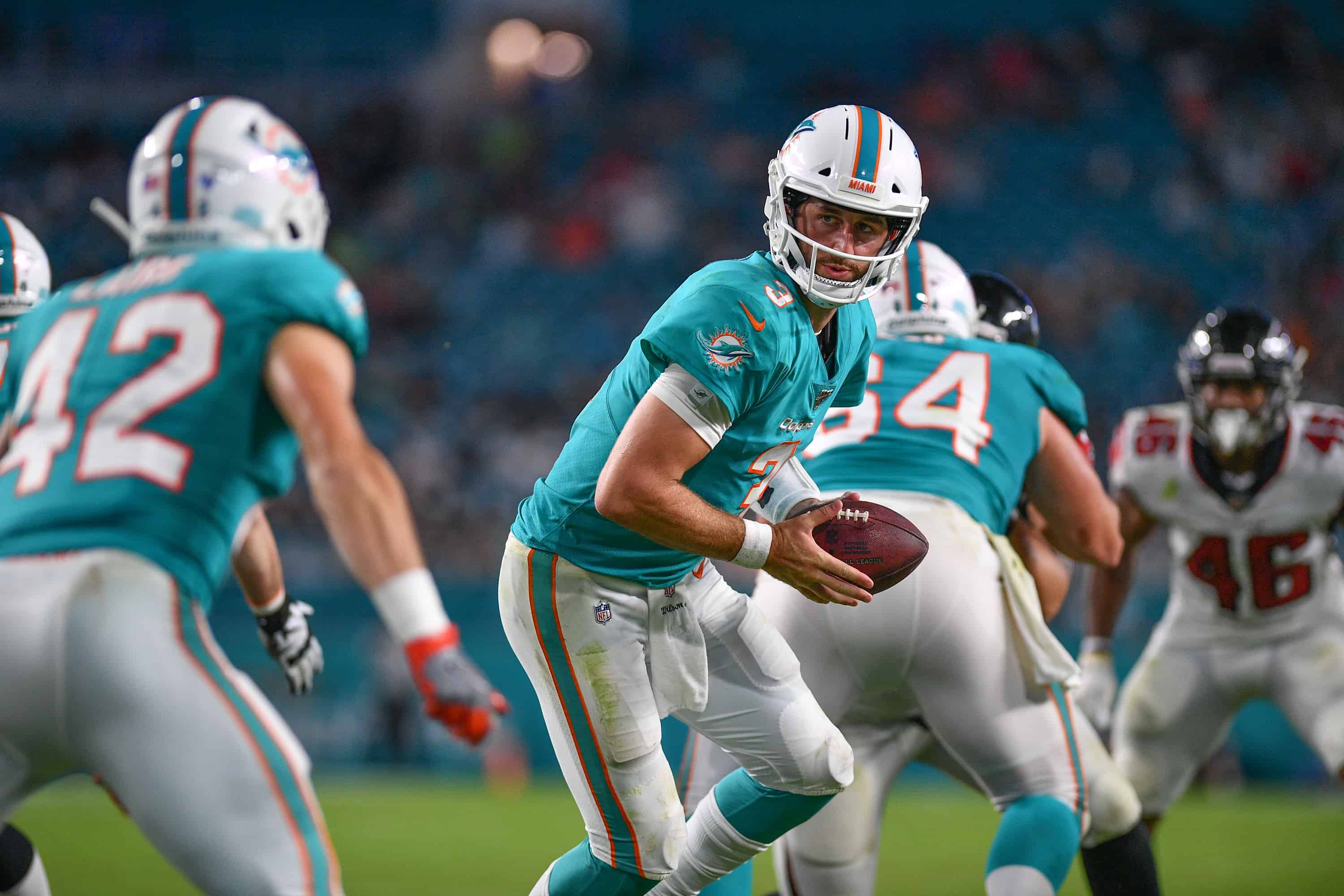- Play-calling and a bad offensive line created worst-case rookie season scenario
- Struggles on throws to the outside
- Play-action could be key to turning it around
Josh Rosen is in an odd position for a second-year quarterback who was picked in the top-10 in the NFL draft: he’s on a different team. After a season in which he ranked last in the NFL in three different advanced quarterback evaluation metrics—ESPN’s Total QBR, Football Outsiders’ Defense-adjusted Value Over Average (DVOA), and Sports Info Solutions’ (SIS) Points Earned—the Arizona Cardinals’ new coaching staff shipped him off in favor of Kyler Murray.
Let’s be clear here: if there’s that much statistical consensus about a player’s poor performance, there’s not much positive to be said about his season. But with a fresh start comes an opportunity to pursue some optimism for a guy who was one of the top draft prospects a year ago.
The Football Outsiders Almanac has the Dolphins projected for a league-low 5.1 wins on average this year. Ryan Fitzpatrick is in the fold as competition and Alabama quarterback Tua Tagovailoa has already been rumored as a draft target. Rosen should have an opportunity to show he belongs because it behooves the Dolphins to give him that shot, but there might be some time pressure on that development.
Rosen can have a better sophomore campaign if he struggles less with the following:
- Poor offensive line play and additional poor performance in pressure situations
- Ineffectiveness when not using play action
- Inaccuracy, particularly on shorter routes and out-breaking routes
Let’s take a more detailed look into those factors and see where the Dolphins and Rosen might focus.
Josh Rosen 2018 Statistics
| Category | Result |
|---|---|
| Attempts | 393 |
| Yards | 2,278 |
| Comp Pct | 55% |
| Catchable Pct | 67% |
| TD-INT | 11-14 |
| Points Earned (Rank) | -29 (38) |
| Rushing Points Earned (Rank) | 0 (23) |
Points Earned Per Attempt Ranks (38 Quarterbacks with 150+ Attempts)
| Situation | Attempts | Rank |
|---|---|---|
| vs. Man | 161 | 34 |
| vs. Zone | 148 | 34 |
| Short/Intermediate Pass | 346 | 38 |
| Deep Pass | 47 | 31 |
| Pressured Pocket | 133 | 31 |
| Clean Pocket | 259 | 38 |
* Points Earned is an SIS total value statistic that distributes Expected Points Added value to the players involved on a play based on their specific involvement, as measured by charting data. For more info, see this article that introduced it.
The Pressure Was On
As important as anything in Rosen’s rookie season was that he was under pressure constantly. The Cardinals’ offensive line had a bad season. They were 26th in the NFL by Football Outsiders’ Adjusted Sack Rate and 29th in SIS’s Pass Blocking Points Earned.
Beyond that, the Cardinals’ play-calling did him no help. The league as a whole used drops of three steps or shorter 65% of the time in 2018 and the Cardinals used shorter drops only 55% of the time with Rosen, third-lowest among quarterbacks. There was a large split in that respect between his two offensive coordinators. In his four starts under Mike McCoy from Weeks 4 to 7, he was right at the league average, but with Byron Leftwich calling the plays, short drops were much rarer.
Josh Rosen’s Pressure Context as a Starter by Offensive Coordinator
| Stat | Mike McCoy (Weeks 4-7) | Byron Leftwich (Weeks 8+) |
|---|---|---|
| Short Drop % | 63% | 51% |
| Overall Pressure% | 43% | 41% |
| Pressure% (Blown Block) | 9% | 15% |
| Pressure% (No Blown Block) | 34% | 26% |
Not only was the scheme hurting Rosen as the season wore on, but his linemen also struggled after that point. Rosen was pressured as a result of a blown block on nine percent of dropbacks in his first four weeks as a starter — on par with the league rate — but that rate ballooned to 15 percent after McCoy’s departure.
As it turned out, that coincided with Rosen’s non-blown-block pressure rate (something more attributable to the quarterback) dropping by around the same amount. So, even if he made some tweaks to find himself in fewer binds, there’s only so much he can do if the coaching staff and offensive line aren’t holding up their end of the bargain.
Here’s the problem, though: Miami is one of the few places where Rosen could have gone and not improved his blocking situation. The Dolphins were 31st in Adjusted Sack Rate and 30th in Pass Blocking Points Earned in 2018, and are already showing signs of offensive line uncertainty heading into 2019.
Fake It ‘Til You Make It
If you don’t have great personnel to keep your quarterback clean, some kind of scheming might help. One possibility would be to find opportunities to exploit personnel groupings, like passing more out of typical run formations. If offseason addition Dwayne Allen gets healthy and athletic prospect Mike Gesicki grows in his second year, an increase in passes from 12 personnel could be an option. The Dolphins’ new coaching staff came from New England, who used 12 and 21 personnel more than average, so there’s already some comfort with those looks.
Another would be to lean on play-action passing. Rosen won’t have David Johnson behind him this year, but fortunately, he can still take advantage of play fakes without an elite running threat behind him.
There’s plenty of support for increased use of play-action on this site, but here are a couple of stats to add to the endorsement. In 2018, per SIS, the NFL averaged 0.13 Expected Points Added (EPA) per play on play-action dropbacks, compared to 0.02 on straight dropbacks. Despite offenses being more inclined to push the ball downfield after a play fake, the “Bust Rate” (rate of plays losing at least one expected point) is right around half that of straight dropbacks. And that includes the possibility of sacks.
Rosen benefited as much from play action in 2018 as anyone. Among the 33 passers with at least 200 attempts last season, he was third behind Tom Brady and Kirk Cousins in how much play-action improved his EPA per play. And again, the new coaching staff came from Brady’s team, so maybe they can provide some play-action secrets.
The way that Rosen benefited from play-action wasn’t typical, though. On average, quarterbacks perform better when throwing deeper (to a point) and when throwing from play-action. As throws go beyond 20 yards, though, play-action passes remain valuable while straight drops start losing efficiency.

Rosen had a different phenomenon going. With play-action, his performance improved with deeper throws, consistent with the league trend. However, on straight dropbacks, he had terrible results on throws behind the line of scrimmage and his EPA per play dropped off a cliff beyond 10 yards. His 49 Independent Quarterback Rating (IQR) on throws 10 or more yards downfield without play-action ranked second-worst in the league (minimum 50 attempts). IQR takes the standard Passer Rating formula and emphasizes factors within the passer’s control by accounting for drops, off-target passes, etc.
Regardless of play-action or not, having some more explosive athletes on the outside than he did in Arizona should help on those deeper throws.
Handling Pressure With and Without Play-Action
Let’s take these two larger points about pressure and play-action passing and bring them together briefly.
As you might not be surprised to hear, pressure was a big factor in Rosen’s poor performance on intermediate or deeper throws, but it was only when he didn’t have the benefit of play-action.
Again, we’ll consider just those 10+ yard throws. When he was pressured on a straight dropback, he had the lowest Catchable Percentage (32% on 34 attempts). When he was pressured after a play fake, his catchable rate jumped to a perfectly-serviceable 67% (14-of-21).
There isn’t an obvious reason why a quarterback would have more trouble throwing deep balls under pressure when he didn’t have the benefit of play-action, so normally it’d be something you’d expect to balance out over time. However, Rosen was also notably more accurate on those throws from play-action in each of his last two seasons in college. So, if there’s a place for the Dolphins’ new coaching staff to target, that might be a good place to start.
Unforced Errors on the Outside
Rosen’s biggest bugaboo independent of any of the people around him was inaccuracy. He threw the lowest percentage of catchable passes in the league (68%).
One area where young quarterbacks need to be careful is on out-breaking routes, which when timed or placed poorly can lead to big interceptions. For this purpose, we’ll consider outs, corners, comebacks, and flats as the starter set of out-breaking routes.
Even without pressure in his face, Rosen struggled with those routes. His 67 percent catchable rate on clean-pocket out-breaking routes was nine percentage points lower than anyone else with at least 30 such attempts. His three interceptions on 48 attempts also gave him the highest interception rate. In his last season at UCLA, his throws were catchable 89 percent of the time in those spots, which was in the upper tier in the country. Accuracy tends to be one of the more sticky traits from college to the pros, so the optimistic view is that this isn’t something that’s a true blind spot for him, and he’ll look better on those routes this year.
Beyond his own inaccuracy, Cardinals receivers failed to bring in a large chunk of those throws even when they were catchable, as he completed only half of those 48 attempts. Most quarterbacks in the league had completion percentages in the mid-seventies or higher on those throws.
That point about receivers is worth expanding upon. Rosen won’t be benefiting from the retooled receiving corps in Arizona this year, but he also will no longer head the team who caught the fifth-fewest catchable passes in 2018. The Dolphins’ pass-catchers were second-best in that metric last year, but lost one of their surest pairs of hands in Danny Amendola in the offseason.
The Last Word
Josh Rosen isn’t being done any favors by having to get accustomed to a new offense and new teammates after a disappointing rookie season. But his coaching staff and teammates often made his job harder last season, so the change of scenery might prove to be a boon to his still-young career. That is, assuming he can do enough to win the job.
While getting used to the new situation, Rosen should also aim to improve his consistency when targeting quicker out-breaking routes, with the aim of avoiding both pressure and dangerous throws.
He should expect to see pressure in his face quite a bit in Miami, so finding any way to manage that from a scheme or decision-making perspective will be paramount. Using play-action to his advantage could be a big key to that, as it can disrupt pass rushers and allow for better looks downfield, and any help that he can get in avoiding tight-window throws will be welcome. But resetting his clock with the team switch should force us to temper expectations for a player who is still an intriguing prospect.
















